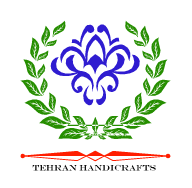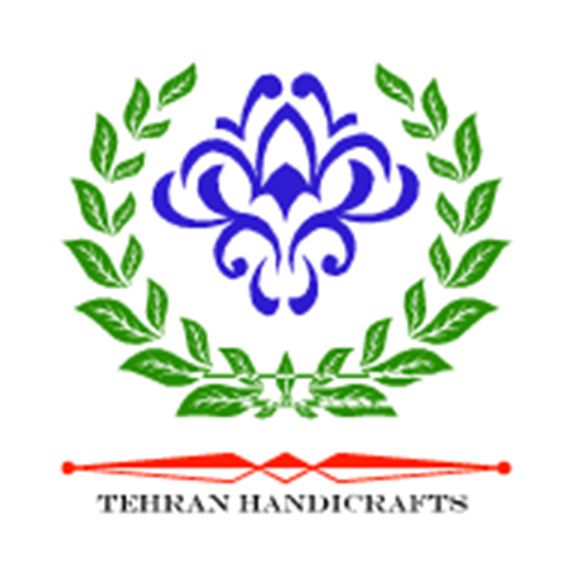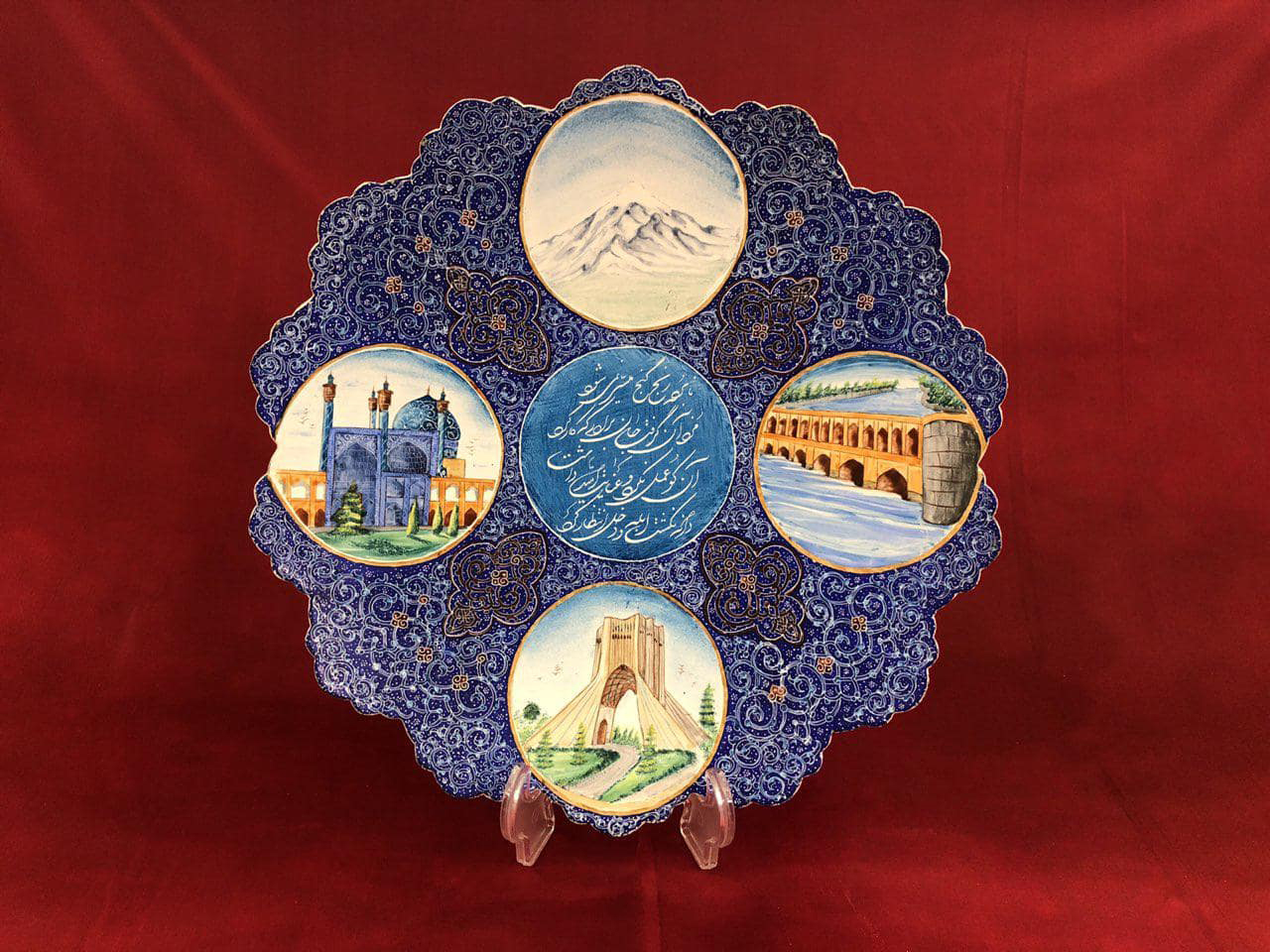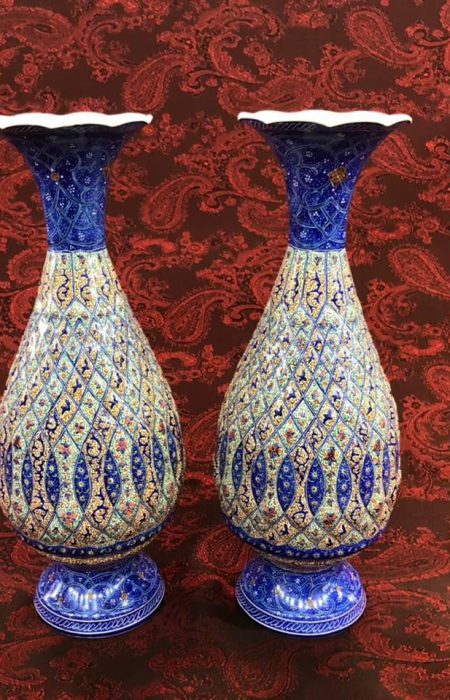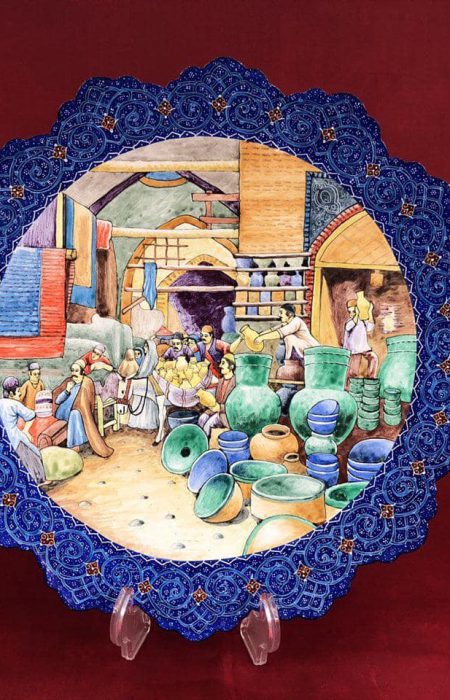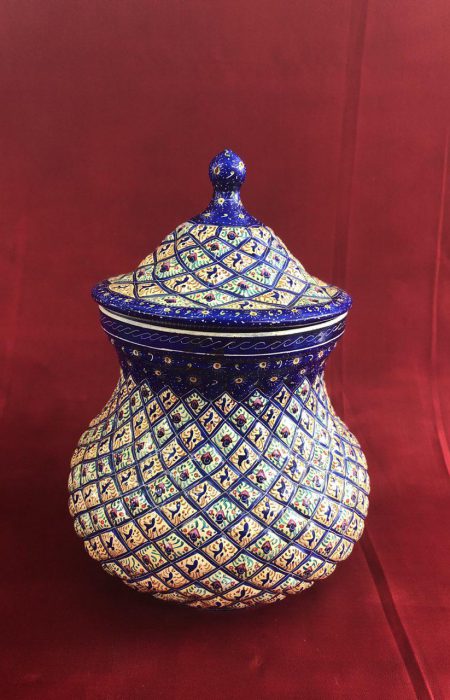Enameling
In this topic we read about: how to make enamel, hisory of enameling, how to recognize a good enamel
Enameling is a painting and decorating of metals such as gold, silver and copper with special colors that are placed in extreme heat. history of enameling back to around 1500 BC. In this article, we’ll learn how to make enamel and how to detect good enamel.
According to studies, enameling was initially formed in Iran and then moved to different parts of the world. The enamel is transparent and comes from the combination of metal oxides and several salt types. The enamel should be placed in the vicinity of the high temperature(750 to 850 ° C) so that the colors can form in sufficient time and temperature . Today, enamels are made mostly on copper, but gold and silver are also good options for use in this art. Gold is the only metal that is not oxidized by the melting of enamel. Therefore finer designs can be made, and obviously its production cost is much higher.
In short, for a enamel, the metal object must first be shaped into a specific shape and size, and then the white glaze is placed on it. Glazing of the surface is done three to four times. Each time the object is heated to about 700 degrees in the furnace to confirm its glaze. Then it turns coloring , and then the object is placed again in the furnace at temperature about 400 to 500 degrees.
Painting enamel
In the painting enamel, they create images on transparent glazes. First, the original object is created and then the original object is covered with white glaze. Glazing is repeated three to four times, and each time the object is placed in a furnace with 700 degrees of heat. It is given to the object to give the glaze a stable color. The object turns white and then the painting operation begins. After painting the object again in an oven of about 400 to 500 degrees to stabilize the colors. In the past, herbal and mineral colors have been used, but today chemical paints are used. The transparency factor is tin oxide. In the past, handicraftman first supplied powdered silica and metal burgers. Then it was darkened with tin and heated to darken the object. Then draw images in different colors on the field.
:The most common methods of painting enamel are
1. The handicraftman combines very soft powder colors with water and a little glycerin. Then dissolves it using specially designed knives on a glass plate. Then create an image like a regular drawing of watercolor.
2. Instead of combining paint with water and glycerin, it is mixed with the extract of pine essence or lavender essence and painted on the objects in the manner of oil painting.
Maintenance of enamel
The enamel product has a lot of value and should be carefully maintained. The following simple tips can keep this memorable life in your home forever.
enamel covered with transparent glazes so you can wash it with warm water and sponge, But avoid pulling the dishwasher on it.
Do not cut sharp objects on the enamel surface.
High heat can damage the enamel and burn it, so be careful about this.
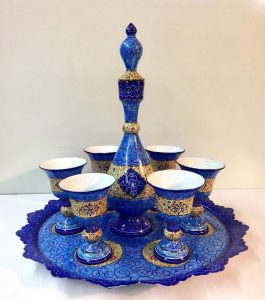
Work tools
The following items are required in enameling
Sheets, honey, enamel, copy paper, hammer, anvil, clamp, sawing bow, metal scissors, brush, paint, furnaces, chemicals such as silica, Sodium carbonate, potassium carbonate, lime and tin and lead.
Click here to learn more about khatamkari and firozekobi.
Types of enamel
:The enamel is divided into several types in the production method in enameling
Highlighting Enamel
In this kind of enamel, drawings and lines are carved on the object. Then they fill the gaps with colored glazes and place them in the furnace for heating:
Khane-bandi enamel
Khane-bandi enamel is an old method in which very thin wires are used. handicraftman form wires in beautiful shapes and glued on the base object and use a glass glaze to cover it. For the wires to be tied to the main object, he place it in a furnace with a temperature of about 1000 ° C. In the next step, special colors are used in powder form to cover the surface then place it in the furnace at about 1000 degrees for 3 minutes . When the wires are in the furnace, their color is black and must be returned to the original color by acid.
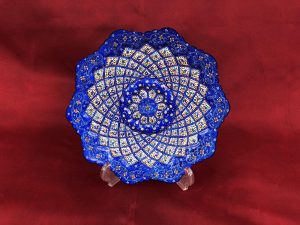
how to recognize a good enamel
The common type of enamel is usually made on copper. You need to know that fine copper also has more weight. so the easiest way is to get the product in your hands and weigh it. If the product does not fit its size properly, then the copper has a lower quality and a high probability of deterioration.
Next, discard the product surface. If it was perfectly smooth, you would have bought a good product.
If the surface was rough, it means that the glaze has lost its quality due to the excessive temperature of the furnace or the length of time it remains in the furnace. Of course, the use of imperceptible colors can also cause surface roughness. When shopping, take care to leave, lips, shells, bubbles, holes and more.
The smooth and uniformity of the underlying product is also an important point in detecting high quality enamel.
Design elegance and high color variation increase the value of the product. Use of a specific color such as red or purple will also increase the price of the product.
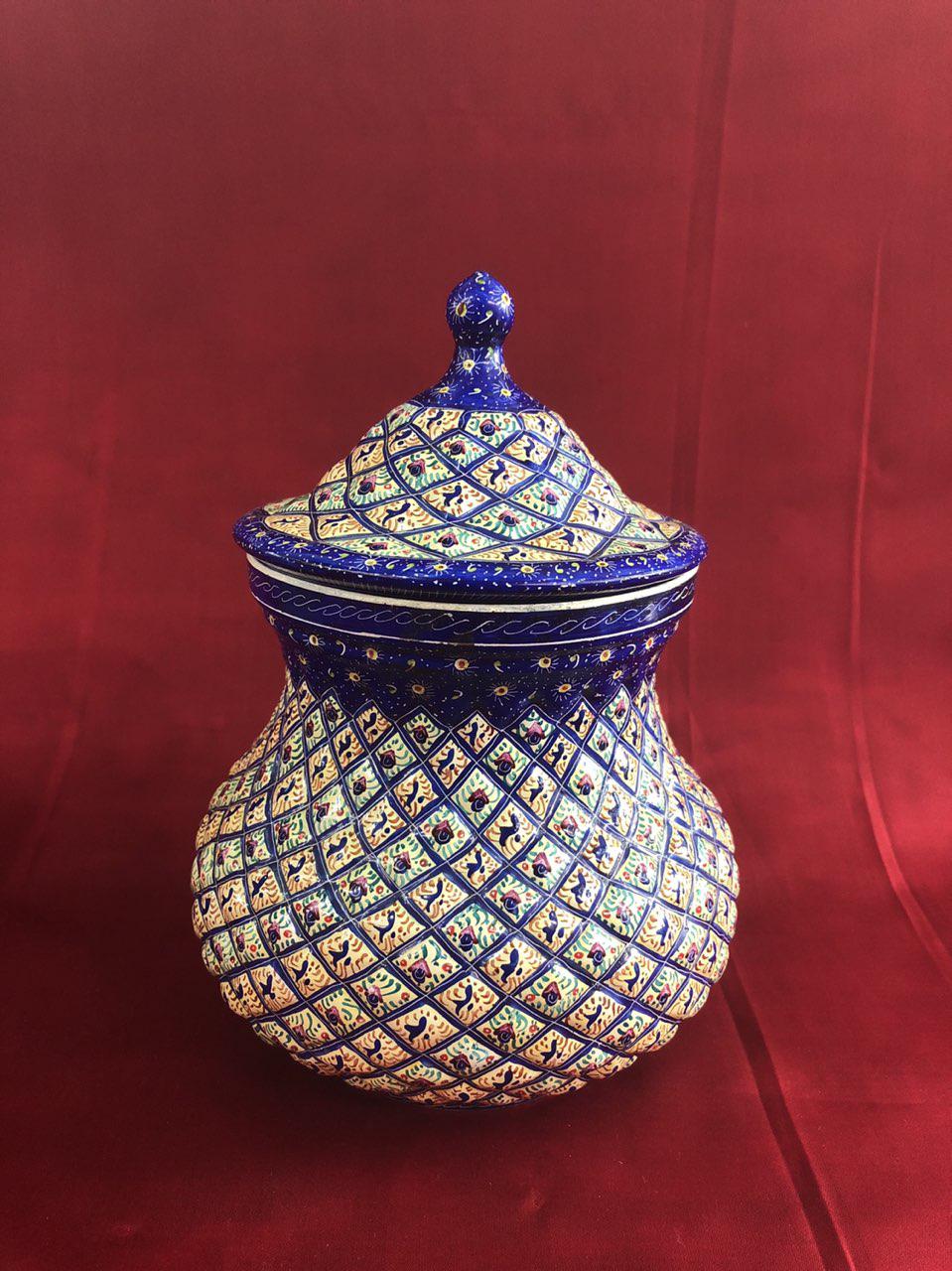
HOW TO MAKE ENAMEL
A. Building a sheet or infrastructure
In order to supply the enamel product infrastructure, craftsman use the following methods
:Bending method
Handicraftman put Plates various mold such as plate, pot, or any other object between the clips. Place the metal plate inside the mold and press it with a rod that is completely rounded so that the sheet is shaped like a mold.
:Hammering method
This method is done without using the mold and the craftsman uses the various types of hammer and other tools
to create the required objects. After each hammering, the object is placed in the fire, and the process continues so
that the object looks like it is.
Clean up the infrastructure level
In the second step, the surface of the metal is completely cleaned to allow glaze to adhere to it. This is very important in enameling even the handicraftsman fingerprint should not remain on the infrastructure as its fat prevents direct glazing from the object and creates cracks in the surface of the glaze.
:To clean the infrastructure surface, use one of the following three methods
:Salt and Vinegar
Fill a glass tank of vinegar and salt and immerse the object in it, or pour it on the vinegar, then pour it with salt and use the wire brush to remove the stains.
:Sulfuric acid
The object is immersed in a warm, dilute sulfuric acid solution to remove stains. If the amount of stains is high, handicraftman use concentrated sulfuric acid and then strike the surface with a wire brush. Finally, you should wash the object with water to remove acid.
:Soap, metal fibers,sandpaper , salt water
In this method, soap and wire brush are used to remove stains, and soap and salt water are also used.
In the end, the object is cleaned with water and dried using sawdust. And before the glazing, using compressor air pressure, dust is removed from the surface of the object.
Glaze preparation
Glaze powder is insoluble and has a high density, so it can not be used alone. they use behdane to make the particles of the glaze hang in water. To do this, they first boil the behdane and get their glaze. Then they mix the concentrate with a ratio of 1 to 10 with glaze powder.
B: GLAZING
:This step is done in two ways
Spray method
They take the infrastructure into a small room called a spray room and spray the glaze with poured on to it.
Handy method or flood
By pouring glazes on the infrastructure, they cover the surface.
Glazing heat
After drying the glaze and cleaning it, the glaze is heated. To do this, the furnace is heated to 900 degrees. Heat, glaze lasts 2 to 3 minutes. After the glaze and the object are red enough, they remove the object from the furnace to cool down. In this case, the glaze can be seen in yellow, but with cooling, its color is white.
C: Design on the glaze
At this stage of enameling, the plot is dragged onto paper. Then handicraftman create holes on the lines of the project and with a short distance, then create with the ash or soot the designs on the glazed section.
Painting
At this stage of enameling, handicraftman draw with pen on the main lines and then paint the different parts. Some prefer to do the painting first and then draw with a pen on the lines.
handicraftman to prepare the paint should mix 1 to 2 gum arabic solution in water with glycerin. Then pour the powder on the glass and put a few drops of the mixture above on it to use it like watercolors. A mixture of arabic gum solution and glycerin, as a color solvent.
If the remaining color is dried, a few drops of gum arabic and glycerin are added to it to paint again.
Interestingly, in enamel colors, there is no white color, and if the handicraftman has to use it, it should use the white enamel of the field. After drawing with pen, the handicraftman threw a sharp tip from the background to reveal a white glaze.
Heating painting
After finishing the painting on the glaze, the object is placed again in the furnace with a temperature of 600 to 700 ° C. Because in the painting step, glycerin or similar oils are used to prepare the paint, the handicraftsman keeps the object on the oven until the oil was removed, otherwise the void may appear on the product.
If the gold is used for coloring, the furnace’s heating should reach a maximum of 450 degrees Celsius, as it will be damaged at higher temperatures. The heating of the furnace during the heating stage must be carefully adjusted and, if the temperature or time is too high,the color moves on the surface. If the temperature and time are less than the required amount, after finishing the paint is removed from the glaze or becomes opaque.
Ultimate Glazing
After heating the object is painted, the object is covered with transparent glaze and once again heated. at the end in enameling If the edges of the object do not glaze, the craftsman will cover them with a strip of brass or silver.
